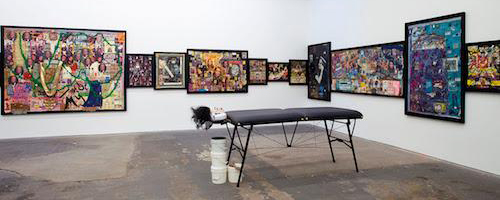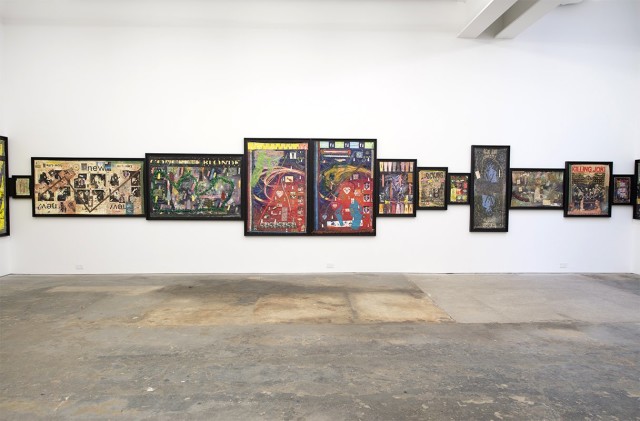
Michael Mahalchick: Skin Game
CANADA
333 Broome St, New York, NY
March 26 – May 1st
There may be nothing more distinctive than a Michael Mahalchick show. In the past, his exhibitions have included a mural made during a performance in which he affixed piece of bacon to the wall with their own fat, a stack of Playboy Magazines topped with a hypodermic needle, a gallery full of objects arranged as though they were simply the refuse in a used hotel room of a rock star.
For his fifth solo show at CANADA Gallery, Skin Game, Michael Mahalchick continues to find inspiration in sex, appropriated media, and the history of rock and roll to create a gallery full of darkly romantic pop culture shrines.
We sat down and discussed the significance and the meaning behind the ephemera, and discarded objects he chooses. We also discussed his performances, which have always played a vital role in his work; the last iteration will be taking place May 1 at the gallery.
What made you decide to call your show Skin Game?
Well, this whole show is latex and rubber! I wanted to engage in this idea of identity, and the idea of skin being who you are. The sack that contains you! The skin is your edge! Then again it’s always flaking off and changing. It’s never stable, little bits and pieces—those come in, and go out.
Your collages are made up of ephemera and they’re covered in skin. You’re literally pointing to how impermanent we all are.
These are very non-archival. Latex deteriorates. These pieces are performing in a way, they age like we age, and they’re not a stable thing. The materials that are imbedded into the skin, some of it is junk from the packaging of ice cube trays that I bought, some are old letters from friends, corks from a celebration that I happened to save, postcards from old shows, postcards from old friends’ shows. This is about me processing these memories.

“Bananarama,” 2016. Rubber coated, mixed media
Does this physical montage of your memories give you some sort of removal from the past, or do you feel connected to it?
No, totally connected. Each of these things is a self-portrait of some sort; almost like a scrapbook. These are ephemera that blow into my world; I don’t decide that I’m going to buy twenty posters on eBay! All these posters are found. People find it hard to believe because there are so many rock posters. When I first moved to New York fifteen years ago, and I was moving into my apartment, in the garbage next door there were all these rock posters, and they’ve been hanging around my studio ever since until I figured out what I wanted to do with them.
You’re a bit of a hoarder!
Yeah, I’m trying to fix that!
That’s what’s fascinating about it, too! You express this need to preserve the past, since you know that it’s fading, and impermanent but you also seem to want to give the past this space in order to revere it or understand it.
There’s value there, in all the memories. Because the latex is holding a lot of the stuff close to the surface, potentially stuff could fall off as it ages…
It’s a living thing. It changes, it’s not stable, and it is not in a permanent state.
That’s the real beauty of it. Traditionally in painting, the still life has been about telling a lie; it’s this effort to conceal things, to perfect them, to make things pretty. But both painting and craft can be used to hide vulnerability. These are very raw—you’re not hiding anything.
I’m not trying to fake anyone out. These things are what they are. I don’t cut or alter the objects, I leave them in the state that they’re in. You’ll notice that there are a lot of squares and rectangles compositionally.

“Triple Doors,” 2016. Rubber coated, mixed media
So, it’s important for you to maintain the integrity of the original object. Your collages also seem to be in dialogue with the Dadaist cut-up technique, where they would cut up words and rearrange them in order to create new narratives.
It’s like the whole notion of surrealism, right? The sewing machine, and the umbrella, on the dissecting table, and it all came together? That aspect of surrealism, the cut-up method, of generating meaning through accidental proximity that isn’t evident or clear, is definitely connected to this work. Your understanding of these things is a result of who you are, and not from me telling you how to interpret the story. You derive your meaning from the friction that takes place between these things.
That’s also related to how you’re using these rock posters that someone else collected, adding a layer of your personal ephemera, and arranging them like shrines.
All the posters are bands that I would have loved. The person who collected them isn’t that much different than me in terms of what I listened to in high school. Rock posters function as a sign for identity. When you’re a kid and you put a poster up, it gives you an idea of who you are.
It’s such a different time now, too. Music seems less tangible now than it ever was. When listening to Pandora and Spotify, it’s often the case that no one even knows the names of the bands that are listening to.
[The poster pieces are] definitely about time passing.
You mentioned before that you have an iPod in the gallery continually playing music for the duration of your show.
I have a third generation iPod playing the music. It’s already a past technology that’s faded into the past like an 8track. I filled the iPod with pop music, the kind of music that you’d hear in a commercial setting, like a drug store or a restaurant or the mall. It’s nothing too obscure; you would recognize it. There are enough songs on it that for the duration of the show, no song will play twice!
It’s funny because you’re using very generic music with such a specific system and creating a unique experience that can’t be repeated.
Everyone who comes into the show will have their own specific soundtrack.
It mirrors the banality of life, in that you could have a really boring day, but it will never be the same day ever again!
No! It might make you think of other times in the past. Like if you’re shopping at Duane Reade, and there’s music playing, and you’re not really paying attention to it, and then something will come on, and it will trigger some sort of memory in you or a feeling of what you love and who you think you are. It will transport you! You’re no longer in the boring drug store; you’re having some other kind of moment, that’s both connected to the moment that you’re in, and some kind of past moment that helped mold who you think you are.

“Anicka Yi,” 2016. Rubber coated, mixed media.
You also seem to be critiquing commercialism and value systems, too.
When I visit my family over the holidays, their value systems seem crazy to me. It’s always about who got the nicest car or the biggest diamond ring. None of that stuff means anything in the grander scheme of things.
You seem to have a humanist perspective.
It’s the human condition, right? It’s frailty and impermanence.
You take an environmentalist stance in your work as well, in that you don’t want to waste anything.
I’ve always been extremely fascinated in the idea of objection, and the idea that things are devalued and thrown out because they’re misunderstood.
The discarded object becomes a metaphor for the discarded human.
Definitely.

“Narcissus IV,” Installation View.
You’ve also been performing in the gallery. Could you talk about the exhibition’s performances?
At the opening, as well as other nights. I lay face down on a massage table, with the thing where you place your face in the hole. I stare down a bucket of water, that’s been painted black, so it becomes a mirror. Instead of me greeting visitors at the gallery it’s me lying on a massage table staring into a bucket of water. This flips this expectation of who I am as the artist. Is this all masturbatory navel gazing in some way or is it a deeper engagement with understanding of who I am? People could see it as pretentious. A lot of times people assume that performance artists are ego driven narcissists. So what is this notion? Ok, so I’m looking like Narcissus in this bucket, and I’m transfixed in what is supposedly this ego inflating moment of the opening of the solo show. I don’t get to get that sort of engagement, but people get to see me engaging with myself on a massage table, which suggests some sort of pleasure and the body.
You’re flipping the script; you like to flip the script!
I do like to flip the script, but I’m also in an incredibly vulnerable spot. At your opening, you’re not in a vulnerable spot at all. Even if your show is shitty, people come up to you saying, “Your show’s soooo good!” I also like the bucket of water, because there’s this idea of deepness, in a way that the mirror doesn’t have that deepness.
That’s comical, because buckets seem deep, but they’re actually shallow.
It’s deep, but it’s also shallow! It’s also a by-product of making the show itself.
There are always double meanings in your work.
Yes! I’m thinking that after the show, I’ll make something out of this water that I’ve stared at. So there’s this notion that somehow something transferred from that process, and has embedded the water with some kind of essence of my identity. Water is flowing, and fits to anything. It evaporates eventually, and becomes something else, just as in death.

Michael Mahalchick, Skin Game. Installation View, 2016.


Comments on this entry are closed.
{ 1 trackback }